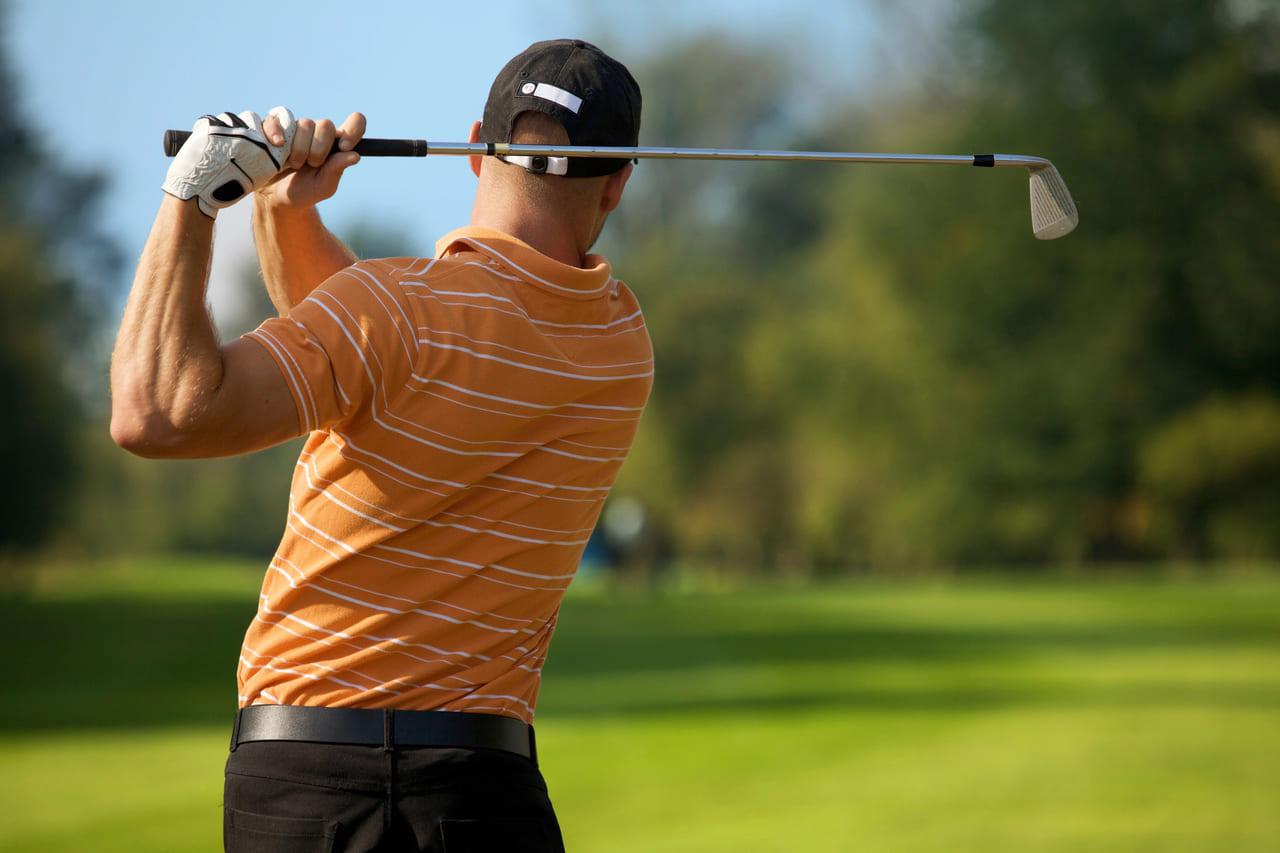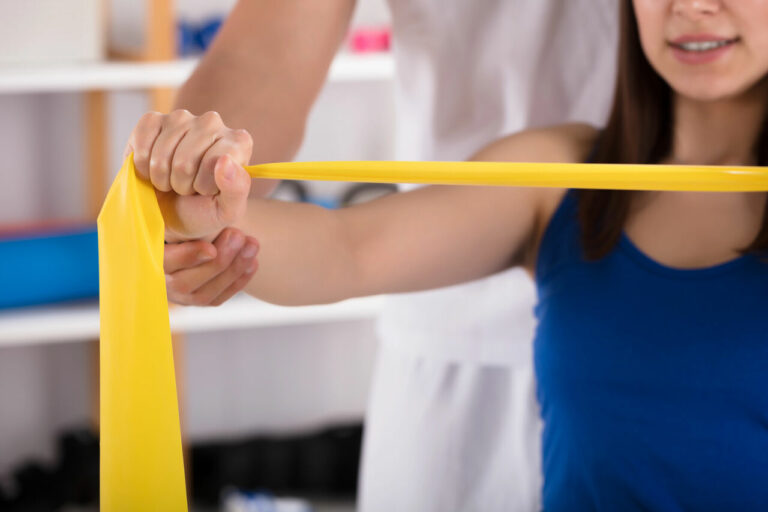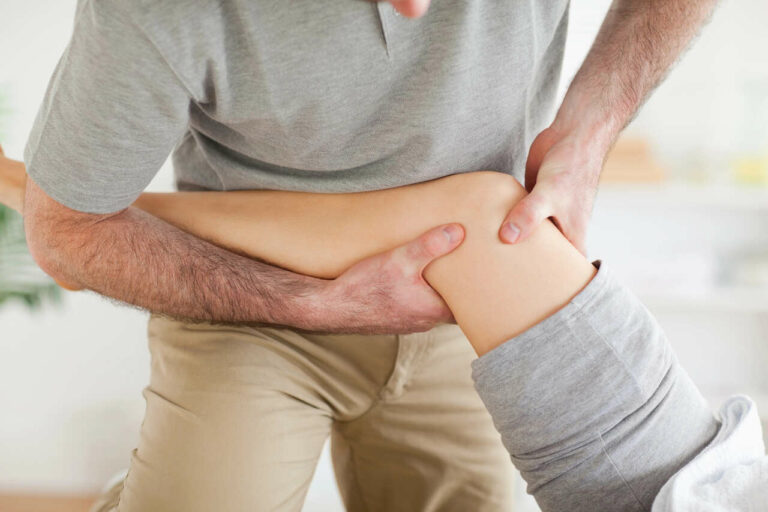Managing Golfer’s Elbow With Exercise: Strengthen and Restore
Golf enthusiast or not, dealing with any form of elbow pain can be daunting, especially when it impacts your daily activities. Golfer’s elbow is a common condition that results from repetitive stress on the tendons connecting the forearm to the elbow. This condition can severely limit your range of motion and ability to perform tasks. In this blog, we will explore various exercises that can aid in recovering from golfer’s elbow, including strengthening and stretching routines, and discuss how to safely progress these exercises. We’ll also examine the role of posture and the benefits of working with a physiotherapist to tailor a plan just for you.
Understanding Golfer’s Elbow
Golfer’s elbow is a type of tendinopathy that affects the tendons on the inside of the elbow. Unlike tennis elbow, which impacts the outer elbow, golfer’s elbow involves the tendons responsible for flexing the wrist and fingers. The condition is often the result of overuse, particularly in activities requiring repetitive wrist and forearm motions, such as golf, racket sports, or manual labour. Symptoms include pain and tenderness on the inside of the elbow, stiffness, and sometimes a tingling sensation radiating into the fingers. These symptoms may appear gradually or suddenly, depending on the nature of the activity causing the stress.
A comprehensive understanding of golfer’s elbow is crucial for effective management and recovery. The condition not only affects athletes but also those who engage in repetitive hand and wrist activities. Identifying the symptoms early can lead to more effective treatment and quicker recovery, allowing individuals to return to their activities pain-free.
Managing Golfer’s Elbow: The Role of Exercise
Exercises are pivotal in both the recovery and management of golfer’s elbow. They help in strengthening the muscles, reducing pain, and improving flexibility. Here are some key aspects to consider:
- Strengthening Muscles: Strengthening exercises target the forearm muscles, enhancing their ability to withstand stress and reducing the risk of future injuries.
- Improving Flexibility: Stretching exercises help maintain flexibility in the forearm muscles, preventing stiffness and promoting a greater range of motion.
- Pain Reduction: Regular exercise can help reduce pain by improving blood flow to the affected area, which aids in healing.
- Promoting Healing: Exercises stimulate the repair of damaged tendons by enhancing circulation and providing the necessary nutrients.
- Correcting Technique: Exercise programs often include correcting form or technique, particularly in sports, to prevent recurrence.
- Balancing Muscle Use: Strengthening exercises can help balance the use of muscles in the forearm, reducing the strain on tendons.
- Gradual Progression: Exercises should be gradually progressed to ensure the tendons are not overstressed, which could lead to further injury.
- Reducing Inflammation: Specific exercises can help decrease inflammation by increasing circulation and reducing stiffness.
Incorporating a structured exercise routine can significantly aid in managing golfer’s elbow. It’s important to tailor the exercises to the individual’s specific needs, ensuring they are both effective and safe.
Supporting the Elbow Joint: Specific Muscles to Strengthen
Strengthening specific muscles around the elbow joint can support recovery from golfer’s elbow. Here are the key muscles to focus on:
- Forearm Flexors: These muscles are directly involved in the condition. Strengthening them can alleviate stress on the tendons.
- Wrist Extensors: While not directly affected, balancing these muscles with flexors can provide better overall support.
- Biceps: Strong biceps can help in stabilizing the elbow joint, reducing excessive strain during activity.
- Triceps: These muscles aid in elbow extension, which is crucial for balanced muscle function around the elbow.
- Shoulder Stabilizers: Strengthening the shoulder muscles can help in reducing compensatory movements that stress the elbow.
- Core Muscles: A strong core provides a stable base, indirectly supporting elbow function through improved overall posture.
- Upper Back Muscles: Strengthening these muscles can improve posture, reducing unnecessary strain on the elbow.
Strengthening these muscles creates a supportive network around the elbow joint, enhancing stability and reducing the risk of injury recurrence.
Recommended Exercises for Golfer’s Elbow
Incorporating targeted exercises into your routine is essential for managing and recovering from golfer’s elbow. These exercises focus on strengthening and improving flexibility in the forearm muscles, which can help alleviate pain and prevent further injury.
- Reverse Wrist Curls: Hold a dumbbell with your palm facing down and curl your wrist upward, then slowly lower it back down. Perform 3 sets of 10–12 reps.
- Eccentric Wrist Flexor Curls: Hold a dumbbell with your palm facing up and, with support, curl your wrist up and slowly lower it back, resisting the motion. Perform 3 sets of 10–12 reps.
- Isometric Wrist Flexion and Extension: Place your palm against a wall and push with moderate force, holding for 10–15 seconds. Perform 3 sets on each side.
- Forearm Supination and Pronation: Hold a dumbbell with your palm facing down and rotate your wrist to turn your palm upward and then downward. Perform 3 sets of 10–12 reps in each direction.
- Elbow Extension with Band: Attach a resistance band to a stable surface, extend your arm fully against the resistance, then return to the starting position. Perform 3 sets of 10–12 reps.
By consistently performing these exercises with proper form, you can support your recovery and reduce the risk of future flare-ups. Always consult with a physiotherapist to ensure you’re progressing safely and effectively.
Recommended Stretching Exercises for Golfer’s Elbow
Stretching exercises are essential for maintaining flexibility and reducing tension in the muscles affected by golfer’s elbow. Here are some effective stretches:
- Wrist Flexor Stretch: Extend your arm with the palm facing up and gently pull back on the fingers with the opposite hand. Hold for 20–30 seconds.
- Wrist Extensor Stretch: Extend your arm with the palm facing down and gently pull back on the fingers with the opposite hand. Hold for 20–30 seconds.
- Forearm Pronator Stretch: With the elbow bent, gently rotate the forearm so the palm faces down. Use the opposite hand for assistance.
- Elbow Flexor Stretch: Extend your arm and gently straighten the elbow to stretch the inner elbow muscles.
- Triceps Stretch: Place one arm overhead and bend the elbow, using the opposite hand to gently push on the bent elbow.
- Shoulder Stretch: Cross one arm across the body and use the opposite arm to press it towards your chest.
Regularly performing these stretches can help alleviate tension, enhance flexibility, and promote healing in the affected area.
Are Grip Strength Exercises Helpful or Harmful for Golfer’s Elbow?
Grip strength exercises can be a double-edged sword when it comes to golfer’s elbow. On one hand, improving grip strength can enhance overall forearm muscle function, providing better support for the elbow joint. Stronger grip muscles can also reduce the compensatory overuse of other muscles, potentially lowering the risk of injury. However, if performed incorrectly or too aggressively, grip exercises can exacerbate symptoms. Overloading the tendons during grip exercises can increase inflammation and pain, potentially prolonging recovery.
It is crucial to incorporate these exercises under professional guidance, ensuring they are performed with proper technique and appropriate resistance levels. Gradually increasing the intensity and frequency of grip exercises can help mitigate the risk of aggravating the condition. In summary, while grip strength exercises can be beneficial, they must be approached with caution and ideally under the supervision of a trained physiotherapist.
Personalized Exercise Plan for Golfer’s Elbow: The Role of Physiotherapy
A physiotherapist plays a vital role in developing a personalized exercise plan for golfer’s elbow. Here’s how they can assist:
- Initial Assessment: A thorough evaluation to understand the severity and specifics of the condition.
- Tailored Exercise Prescription: Creating a plan that considers individual needs, goals, and limitations.
- Technique Training: Ensuring exercises are performed with correct form to maximize benefit and minimize risk.
- Progress Monitoring: Regularly assessing progress and making adjustments to the exercise plan as needed.
- Education: Providing education on the condition, exercise benefits, and self-management strategies.
- Pain Management Strategies: Offering guidance on techniques to manage pain, such as ice application or massage.
- Injury Prevention Advice: Educating on techniques and strategies to prevent future recurrences.
- Motivation and Support: Encouraging adherence to the exercise program and providing emotional support throughout recovery.
A physiotherapist’s guidance ensures a comprehensive and effective approach to managing golfer’s elbow, optimizing recovery outcomes.
Performing Golfer’s Elbow Exercises: The Importance of Proper Form and Technique
Proper form is essential when performing golfer’s elbow exercises to prevent further strain and promote healing. Movements should be slow and controlled, especially during strengthening exercises, to ensure that the muscles bear the load instead of the tendons. When stretching, avoid forcing the elbow into painful positions and hold each stretch gently, without bouncing, to prevent overextending the tendons.
Additionally, always incorporate a proper warm-up to prepare the muscles and a cool-down to reduce stiffness afterward. Consistently focusing on correct form and technique can greatly enhance the effectiveness of your exercises and help avoid re-injury. For personalized guidance, consulting a physiotherapist can ensure that your movements are precise and safe.
When to Perform Golfer’s Elbow for Optimal Benefits
Timing is crucial for maximizing the benefits of exercises for golfer’s elbow. Consider these factors:
- Morning Routine: Performing exercises in the morning can help reduce stiffness from overnight inactivity.
- Warm-Up Inclusion: Incorporating exercises after a warm-up ensures muscles are prepared and reduces injury risk.
- Post-Activity: Doing exercises after engaging in activities that stress the elbow can help alleviate tension.
- Regular Intervals: Consistent practice, ideally daily, helps build strength and maintain flexibility.
- Pre-Activity Stretching: Stretching before engaging in sports or repetitive activities can prepare the muscles and tendons.
- After Rest Periods: Reintroducing exercises after periods of rest can gradually rebuild strength.
- Evening Cool-Down: Performing exercises in the evening can serve as a cool-down, reducing tension from daily activities.
- Pain-Free Times: Engage in exercises during periods when pain levels are lower to encourage participation and effectiveness.
Proper timing and consistency in performing exercises contribute significantly to the effective management of golfer’s elbow.
The Role of Posture in Preventing Golfer’s Elbow Flare-Ups
Posture plays a significant role in preventing flare-ups of golfer’s elbow by ensuring that the body is aligned correctly during activities. Poor posture can lead to increased stress on certain parts of the body, including the elbow. For example, slouching or hunching can cause the shoulders to roll forward, which in turn can lead to overcompensation by the forearm muscles during activities that involve gripping or swinging. This additional stress can exacerbate symptoms of golfer’s elbow. Maintaining a neutral spine and ensuring the shoulders are properly aligned can help distribute forces more evenly throughout the body, reducing the likelihood of overuse injuries.
Additionally, good posture can enhance breathing efficiency and circulation, which aids in muscle function and recovery. By incorporating postural awareness into daily routines and exercises, individuals can significantly reduce the risk of exacerbating existing conditions or developing new ones.
Don’t Let Pain Slow You Down
Understanding and managing golfer’s elbow requires a comprehensive approach that includes targeted exercises, posture correction, and professional guidance. By incorporating the right exercises and avoiding activities that exacerbate symptoms, individuals can significantly improve their condition.
Propel Sports Physical Therapy in Edmonton South offers personalized support to help you navigate your recovery journey. Our team is dedicated to creating tailored exercise plans that cater to your specific needs, ensuring effective and sustainable recovery. Contact us today to start your path toward pain-free movement and enhanced quality of life.







